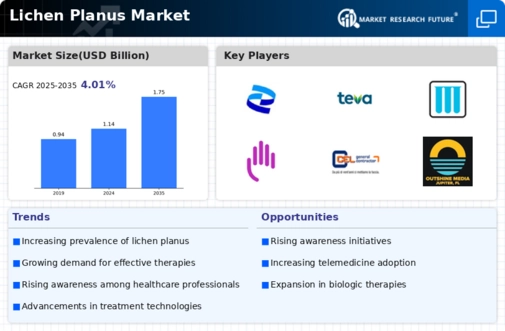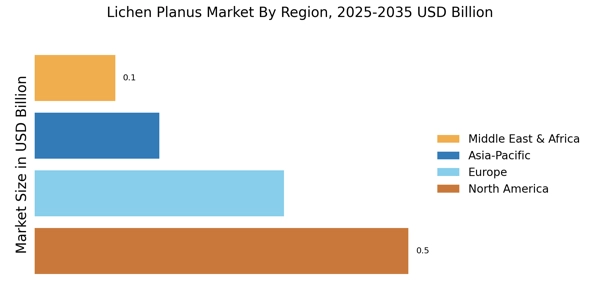Innovative Therapeutic Developments
Innovations in therapeutic approaches are significantly influencing the Lichen Planus Market Industry. Recent advancements in drug formulations, including biologics and targeted therapies, have shown promise in managing Lichen Planus Market symptoms effectively. For instance, the introduction of corticosteroid injections and systemic therapies has provided new avenues for treatment, enhancing patient outcomes. Market data suggests that the global market for dermatological therapies is projected to reach USD 30 billion by 2026, with a notable share attributed to Lichen Planus Market treatments. This trend indicates a growing investment in research and development, as pharmaceutical companies strive to create more effective and safer treatment options. Consequently, the Lichen Planus Market Industry is likely to benefit from these innovative developments, attracting both investment and patient interest.
Increasing Incidence of Lichen Planus
The rising incidence of Lichen Planus Market appears to be a pivotal driver in the Lichen Planus Market Industry. Recent epidemiological studies indicate that the prevalence of this condition is on the rise, affecting approximately 1-2% of the population. This increase may be attributed to various factors, including heightened awareness and improved diagnostic capabilities. As more individuals are diagnosed, the demand for effective treatment options is likely to surge, thereby propelling market growth. Furthermore, the condition's chronic nature necessitates ongoing management, which could lead to sustained revenue streams for pharmaceutical companies. The Lichen Planus Market Industry is thus positioned to expand as healthcare providers seek to address the needs of an increasing patient population.
Enhanced Access to Healthcare Services
Enhanced access to healthcare services is playing a vital role in shaping the Lichen Planus Market Industry. The expansion of healthcare infrastructure, particularly in underserved regions, is facilitating earlier diagnosis and treatment of Lichen Planus Market. Telemedicine and digital health platforms are also contributing to this trend, allowing patients to consult specialists remotely. Data indicates that telehealth usage has increased by over 50% in recent years, providing patients with greater access to dermatological care. This improved accessibility is likely to lead to higher diagnosis rates and, consequently, increased demand for treatment options in the Lichen Planus Market Industry. As healthcare systems continue to evolve, the potential for market growth remains substantial.
Rising Demand for Personalized Medicine
The shift towards personalized medicine is emerging as a significant driver in the Lichen Planus Market Industry. Patients increasingly seek tailored treatment plans that consider their unique genetic and environmental factors. This trend is supported by advancements in genomic research and biomarker identification, which enable healthcare providers to customize therapies for better efficacy. Market analysts project that the personalized medicine sector will grow substantially, potentially reaching USD 2 trillion by 2025. As healthcare systems adapt to this paradigm, the Lichen Planus Market Industry may witness a surge in demand for personalized treatment options, fostering a more patient-centric approach to managing this condition.
Growing Investment in Dermatological Research
Investment in dermatological research is a crucial factor driving the Lichen Planus Market Industry. Increased funding from both public and private sectors has led to a surge in clinical trials and studies focused on Lichen Planus Market. This influx of capital is likely to accelerate the development of new therapies and improve existing treatment protocols. According to recent reports, funding for dermatological research has increased by over 25% in the past five years, reflecting a growing recognition of the need for effective treatments. As research progresses, the Lichen Planus Market Industry stands to benefit from the introduction of novel therapies that address unmet medical needs, ultimately enhancing patient care.


















Leave a Comment